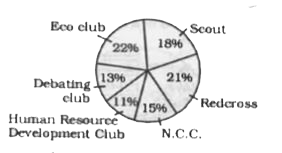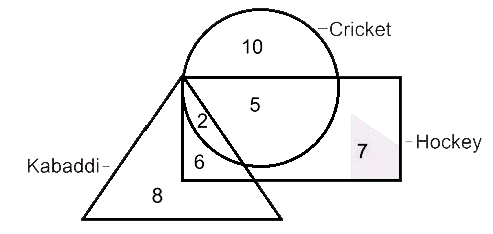It is observed that to a problem like 'Show that the sum of two odd numbers is an even number*, most of the students replied by quoting one example, say, 5+7 = 12. Students answered this question inappropriately as:
students have not understood that in Mathematics 'any' is used to indicate generalisations and hence are not able to answer correctly
students have attained the formal operational stage as proposed by Piaget
students firmly believe that if a statement is true for one set of numbers, it is always true and hence have developed strong strategy for making generalisations
students have not learnt the logical proof for the statement in the class
The correct Answer is:C
Topper's Solved these Questions
Similar Questions
State whether the following statements are True or False :
The sum of two odd numbers and one even number is even.
View SolutionState whether the following statements are True or False:(a) The sum of three odd numbers is even.(b) The sum of two odd numbers and one even number is even.(c) The product of three odd numbers is odd.(d) If an even number is divided by 2, the quotient is always odd.(e) All prime numbers are odd.(f) Prime numbers do not have any factors.(g) Sum of two prime numbers is always even.(h) 2 is the only even prime number.(i) All even numbers are composite numbers.(j) The product of two even numbers is always even
View Solution
Knowledge Check
It is observed that to a problem like 'Show that the sum of any two odd numbers is an even number", most of the students replied by quoting one example, say, 5+ 7 = 12. Students answered this question inappropriately as
AStudents firmly believe that if a statement is true for one set of nunibers, it is always true and hence have developed strong strategy for making generalisationsBStudents have not learnt the logical proof for the statement in the classCStudents have not understood that in Mathematics any' is used to indicate generalisations and hence are not able to answer correctlyDStudents have attained the formal operational stage as proposed by PiagetIt is observed that to problem like 'Show that the sum of any two odd numbers is an even number', most of the students replied by quoting one example, say, 5 +7 = 12 students answered this questions inappropriately as
Astudents have not understood that in Mathematics 'any' is used to indicate generalisations and hence are not able to answer correctlyBstudents have attained th formal operational stage as proposed by PiagetCstudents firmly believe that if a statement is true for one set of numbers, it is always true and hence have developed strong strategy for making generalisationsDstuddents have not learnt the logical proof for the statement in the classIt is observed that to problem like 'Show that the sum of any two odd numbers is an even number', most of the students replied by quoting one example, say, 5 +7 = 12 students answered this questions inappropriately as
Astudents have not understood that in Mathematics 'any' is used to indicate generalisations and hence are not able to answer correctlyBstudents have attained th formal operational stage as proposed by PiagetCstudents firmly believe that if a statement is true for one set of numbers, it is always true and hence have developed strong strategy for making generalisationsDstuddents have not learnt the logical proof for the statement in the class
State whether the following statements are True or False:
(a) The sum of three odd numbers is even.
(b) The sum of two odd numbers and one even number is even.
(c) The product of three odd numbers is odd.
(d) If an even number is divided by 2, the quotient is always odd
.(e) All prime numbers are odd.
(f) Prime numbers do not have any factors.
(g) Sum of two prime numbers is always even
.(h) 2 is the only even prime number.
(i) All even numbers are composite numbers.
(j) The product of two even numbers is always even
View SolutionIn each of the following questions, two rows of numbers are given. The resultant number in each row is to be worked out separately based on the following rules and the questions below the rows of numbers are to be answered. The operations of numbers progress from the left to the right.
Rules:
(i) If an odd number is followed by another composite odd number, they are to be multiplied
(ii) If an even number is followed by an odd number, they are to be added.
(iii) If an even number is followed by a number which is the perfect square, the even number is to be subtracted from the perfect square.
(iv) If an odd number is followed by a prime odd number, the first number is to be divided by the second number.
(v) If an odd number is followed by an even number, the second one is to be subtracted from the first number.
22 27 7
7 9 14
What will be the answer if the resultant of second row is divided by the resultant of the first row ?
1) 7
2) 14
3) 63
4) 48
5) None of these
View SolutionIn each of the following questions, two rows of numbers are given. The resultant number in each row is to be worked out separately based on the following rules and the questions below the rows of numbers are to be answered. The operations of numbers progress from the left to the right.
Rules:
(i) If an odd number is followed by another composite odd number(a non-prime number), they are to be multiplied
(ii) If an even number is followed by an odd number, which is not a perfect square, they are to be added.
(iii) If an even number is followed by a number which is the perfect square, the even number is to be subtracted from the perfect square.
(iv) If an odd number is followed by a prime odd number, the first number is to be divided by the second number.
(v) If an odd number is followed by an even number, the second one is to be subtracted from the first one.
27 12 3
p 9 5
If p is the resultant of the first row, what is the resultant of the second row ?
1) 50
2) 9
3) 40
4) 5
5)8
View SolutionThe pie-chart given below shows the number of students enrolled in a school in different activities. Total number of students in the school is 1200. Study the chart and answer the questions.

How many students are enrolled in N.C.C. activities ?
View SolutionObserve the following diagram and answer the question. Find the number of students who play any two of the three sports.

View Solution
